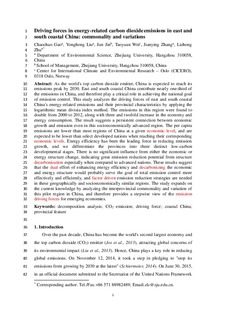| dc.contributor.author | Gao, Chaochao | |
| dc.contributor.author | Liu, Yonghong | |
| dc.contributor.author | Jin, Jun | |
| dc.contributor.author | Wei, Taoyuan | |
| dc.contributor.author | Zhang, Jianying | |
| dc.contributor.author | Zhu, Lizhong | |
| dc.date.accessioned | 2018-02-12T11:42:07Z | |
| dc.date.available | 2018-02-12T11:42:07Z | |
| dc.date.created | 2016-06-05T08:58:47Z | |
| dc.date.issued | 2016 | |
| dc.identifier.citation | Journal of Cleaner Production. 2016, 135 240-250. | |
| dc.identifier.issn | 0959-6526 | |
| dc.identifier.uri | http://hdl.handle.net/11250/2484056 | |
| dc.description.abstract | As the world's top carbon dioxide emitter, China is expected to reach its emissions peak by 2030. East and south coastal China contribute nearly one-third of the emissions in China, and therefore play a critical role in achieving the national goal of emission control. This study analyzes the driving forces of east and south coastal China's energy-related emissions and their provincial characteristics by applying the logarithmic mean divisia index method. The emissions in this region were found to double from 2000 to 2012, along with three and twofold increase in the economy and energy consumption. The result suggests a persistent connection between economic growth and emission even in this socioeconomically advanced region. The per capita emissions are lower than most regions of China at a given economic level, and are expected to be lower than select developed nations when reaching their corresponding economic levels. Energy efficiency has been the leading force in reducing emission growth, and we differentiate the provinces into three distinct low-carbon developmental stages. There is no significant influence from either the economic or energy structure change, indicating great emission reduction potential from structure decarbonization especially when compared to advanced nations. These results suggest that the dual effort of enhancing energy efficiency and decarbonizing the economic and energy structure would probably serve the goal of total emission control more effectively and efficiently, and factor driven emission reduction strategies are needed in these geographically and socioeconomically similar regions. The study expands on the current knowledge by analyzing the interprovincial commonality and variation of this pilot region in China, and therefore provides a stepwise view of the emission driving forces for emerging economies. | |
| dc.language.iso | eng | |
| dc.title | Driving forces in energy-related carbon dioxide emissions in east and south coastal China: commonality and variations | |
| dc.type | Peer reviewed | |
| dc.type | Journal article | |
| dc.description.version | submittedVersion | |
| dc.source.pagenumber | 240-250 | |
| dc.source.volume | 135 | |
| dc.source.journal | Journal of Cleaner Production | |
| dc.identifier.doi | 10.1016/j.jclepro.2016.05.131 | |
| dc.identifier.cristin | 1359635 | |
| dc.relation.project | Norges forskningsråd: 209701 | |
| cristin.unitcode | 7475,0,0,0 | |
| cristin.unitname | CICERO Senter for klimaforskning | |
| cristin.ispublished | true | |
| cristin.fulltext | preprint | |
| cristin.qualitycode | 2 | |
